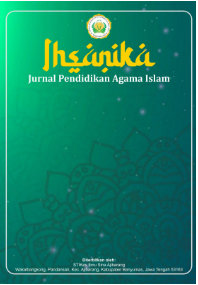Perbandingan Hasil Belajar PAI Antara Siswa Lulusan Madrasah Tsanawiyah (MTs) dan Sekolah Menengah Pertama (SMP) Kelas X di SMAN 1 Banuhampu
DOI:
https://doi.org/10.59841/ihsanika.v3i1.2343Keywords:
Learning Outcomes, MTs Graduates, SMP GraduatesAbstract
This research was motivated by the discovery that students who graduated from Junior High School (SMP) were more active and superior than students who graduated from Madrasah Tsanawiyah (MTs) in Islamic Education learning. This is of course a problem, because basically, in PAI learning, students who graduate from Madrasah Tsanawiyah (MTs) must be superior to students who graduate from Junior High Schools (SMP) because students who graduate from Madrasah Tsanawiyah (MTs) are students with notaben educational backgrounds religion school. This is of course a problem that must be resolved. So this research aims to compare the PAI learning outcomes of the two graduates and see how comparable they are. The type of research used in this research is comparative with a quantitative approach. The population is all class The sample in this study used a cluster random sampling technique, and 4 classes were sampled, with details of 36 MTs graduate students and 71 junior high school graduate students. Data was collected through documentation and analyzed independent sample t tests. Based on the results of research that has been carried out, research results show that there is a comparison of student PAI learning outcomes between MTs and SMP graduates, which is proven by the results of the independent sample t test where the calculated t value > t table is 8.332 > 1.985. And student PAI learning outcomes are higher for MTs graduate students as evidenced by the mean difference value in the independent sample t test of 7.329, which means that MTs graduate students have an average PAI learning outcome score of 7.329 higher than the PAI learning outcomes of junior high school graduate students so that Ha accepted.
References
Alawiyah, F. (2014). Pendidikan madrasah di Indonesia. Aspirasi Jurnal, 5(1), 54.
Arif, M., & Ferdinan. (2023). Perbandingan hasil belajar mata pelajaran Pendidikan Agama Islam kelas X antara siswa lulusan SMP dan MTs di SMA Muhammadiyah Kalosi Kab. Enkerang. Jurnal AL Urwatul Wutsqa, 3(2), 40.
Fitriani. (2016). Pengaruh motivasi belajar dan disiplin terhadap hasil belajar IPS siswa di SMP Karya Indah Kecamatan Tapung. Jurnal Peka, 4(2), 138.
Hamalik, O. (2008). Perencanaan pengajaran berdasarkan pendekatan sistem. Bumi Aksara.
Hasbullah. (2003). Dasar-dasar ilmu pendidikan. Raja Grafindo Persada.
Johnson. (2017). The impact of Islamic education on student’s academic achievement. International Journal of Islamic Studies, 3(2), 78–92.
Mufarihah, A. F., & Anwar, M. A. (2019). Perbandingan hasil belajar antara siswa madrasah diniyah dengan siswa non-madrasah pada mata pelajaran PAI di Madrasah Tsanawiyah. Jurnal Manajemen dan Pendidikan Islam, 5(1), 40.
Pratama, A. R. (2023). Implementasi metode brainstorming dalam pembelajaran Pendidikan Agama Islam di kelas XI SMA Negeri 4 Bukittinggi. Madinah: Jurnal Studi Islam, 10(1), 120–130. https://doi.org/10.58518/madinah.v10i1.1496
Pratama, A. R., Aprison, W., Wati, S., Iswantir, M., & Irsyad, W. (2024). Pengaruh mind mapping terhadap berpikir kritis dan hasil belajar siswa. Jurnal Bimbingan dan Konseling Ar-Rahman, 10(1), 158–170. https://doi.org/10.31602/jbkr.v10i1.14287
Purwanto, M. N. (2014). Psikologi pendidikan. Remaja Rosdakarya.
Shubchan, M. A., & Rossa, M. A. (2021). Memahami latar belakang pendidikan peserta didik: Telaah tentang transfer dan transformasi belajar. Jurnal Perspektif, 1(2), 168. https://doi.org/10.53947/perspekt.v1i2.60
Smith. (2018). The impact of Islamic education on students' understanding of Islamic studies. Journal of Islamic Education, 3(2), 45–56.
Downloads
Published
How to Cite
Issue
Section
License
Copyright (c) 2024 IHSANIKA : Jurnal Pendidikan Agama Islam

This work is licensed under a Creative Commons Attribution-ShareAlike 4.0 International License.









